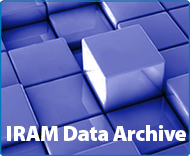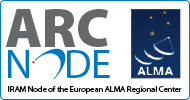Terms of use | Contact us
Copyright © 2009-2023 IRAM. All rights reserved.
YOU ARE ON THE LEGACY WEBSITE OF IRAM. YOU WILL FIND THE CURRENT WEBSITE HERE.
2015 News
November 13, 2015
IRAM and ALMA link to create Earth-size virtual telescope
IRAM and ALMA link to create Earth-size virtual telescope
In a series of recent Very Long Baseline Interferometry (VLBI) observations, ALMA was succesfully linked to the IRAM 30-m antenna (located in the Sierra Nevada of southern Spain) and to NRAO's VLBA antennas in the United States.
November 10, 2015
Inauguration of the Bure cable car: a new access to science
Inauguration of the Bure cable car: a new access to science
On 2nd of October 2015, the new cable car to the NOEMA observatory was inaugurated with the presence of participating companies, the IRAM staff and numerous officials from the partner organizations as well as local authorities and representatives.
03 November, 2015
Winter 2015/16 ratings now on line
Winter 2015/16 ratings now on line
The IRAM program committee convened in Grenoble on October 21 and 22 to evaluate the proposals submitted for the winter 2015/2016 scheduling period. The discussions were organized in 2 panels which were chaired by Javier Goicoechea (ICMM-CSIC, Madrid) and Ric Davies (MPE, Garching).
The authors of each proposal will be informed shortly by email, including the comments issued by the committee.
As usual, the proposals were classified A (accepted), B (backup), and C (rejected).
October 23, 2015
Ethyl alcohol and sugar in a comet!
Ethyl alcohol and sugar in a comet!
An international team led by French researchers from LESIA and LERMA (both Observatoire de Paris) announces the first detection of ethyl alcohol (C2H5OH) and the simplest sugar, glycolaldehyde (CH2OHCHO) in comet C/2014 Q2 (Lovejoy). Putting into evidence an important organic complexity in cometary material is provding key information to get a better understanding of the conditions that lead to the emergence of life on Earth
October 6, 2015
IRAM reveals a large reservoir of organic material in the starless core L1544
IRAM reveals a large reservoir of organic material in the starless core L1544
Placed in the Taurus star forming region, at about 450 light-years from Earth, L1544 is the prototype of prestellar cores, the cold gas condensations on the verge of collapsing to form new stars. An unbiased frequency survey of this dense core has been carried out with the IRAM 30-m radiotelescope, as a part of the Large Program ASAI (Astrochemical Surveys at IRAM; Lefloch, Bachiller et al. 2015), and has recently been used by Vastel et al. (2014, 2015) to provide the full census of oxygen bearing complex organic molecules (COMs) in its central region. As an example, Figure 1 shows the richness of the spectrum in the frequency range from 81 to 89 GHz, together with the identification of the most prominent lines.
September 1, 2015
Is the black hole in NGC 1277 really obese?
Is the black hole in NGC 1277 really obese?
It is well known that each galaxy hosts in its nucleus a super-massive black hole, of mass equal to 0.2-1% of its bulge mass. Recently a few exceptions of over-massive black holes might have been discovered, although this is still under debate. In the lenticular galaxy NGC 1277 in the Perseus cluster, the largest black hole ever has been claimed, through stellar kinematics measurements, to be about 50% of its bulge mass! Some astronomers have contested this value...
August 18, 2015
Call for Proposals, Winter 2015/16
Call for Proposals, Winter 2015/16
The new call for proposals for the winter semester 2015/2016 is available. A detailed description of the observing capabilities of the 30m telescope and the current status of the NOEMA interferometer are given...
August 6, 2015
New IRAM data policy
New IRAM data policy
Read more about the new IRAM data policy. Following a decision of the IRAM partners in June 2015 the following changes are introduced:
June 16, 2015
NOEMA discovers previously unknown extreme star formation region - the ‘Eye of Medusa’
NOEMA discovers previously unknown extreme star formation region - the ‘Eye of Medusa’
NOEMA, the most powerful millimetre radio telescope of the Northern Hemisphere, has unveiled its first astronomical image: a unique and spectacular view of a previously unknown region of extreme star formation in the ‘Medusa merger’ – a luminous collision of two galaxies at more than 100 million light years from Earth.
June 2, 2015
Jérôme Pety and Javier Goicoechea winners of the SF2A-SEA 2015 prize with a program of molecular astrophysics
Jérôme Pety and Javier Goicoechea winners of the SF2A-SEA 2015 prize with a program of molecular astrophysics
IRAM congratulates Jérôme Pety (IRAM, France) and Javier Goicoechea (ICMM-CSIC, Spain), the winners of the SEA-SF2A 2015 prize for outstanding achievements in a French-Spanish scientific research cooperation. The winners received special recognition for the study of...
May 19, 2015
Observational evidence for a new stage in the birth of a star: the first hydrostatic core
Observational evidence for a new stage in the birth of a star: the first hydrostatic core
A research team has found very serious clues for the presence of a first hydrostatic core in a protostellar core located in the Perseus molecular cloud. The first hydrostatic core is a critical phase in the evolution pathway of a prestellar core towards the formation of a star. It’s a challenging premiere because...
April 21, 2015
Summer 2015 ratings now online
Summer 2015 ratings now online
The IRAM program committee convened in Granada on April 14 and 15 to evaluate the proposals submitted for the summer 2015 scheduling period. The discussions were organized in 2 panels which were chaired by Charlotte Vastel (IRAP, Toulouse) and Romeel Davé (University of Western Cape, South Africa). The authors of each proposal will be informed by letter which will include comments issued by the committee if there are any. As usual, the proposals were classified A (accepted), B (backup), and C (rejected).
March 16, 2015
A distant galaxy cluster merger
A distant galaxy cluster merger
A team of scientists using the Goddard-IRAM Superconducting 2-Millimeter Observer (GISMO) on the IRAM 30 meter telescope selected one spectacular cluster previously found by Planck to image at 30 times higher resolution than Planck’s original detection. The cluster they observed, called PLCK G147.3-16.6, was known from early X-ray follow-up observations with the ESA’s XMM-Newton telescope to be a merger of two smaller clusters. To the surprise of the scientists...
February 13, 2015
Call for Proposals Summer 2015
Call for Proposals Summer 2015
Covering the period from June to November 2015, this year’s first proposal deadline for IRAM facilities will be on Thursday March 12, 2015. As usual, the submission facility will be opened about three weeks before the deadline.




